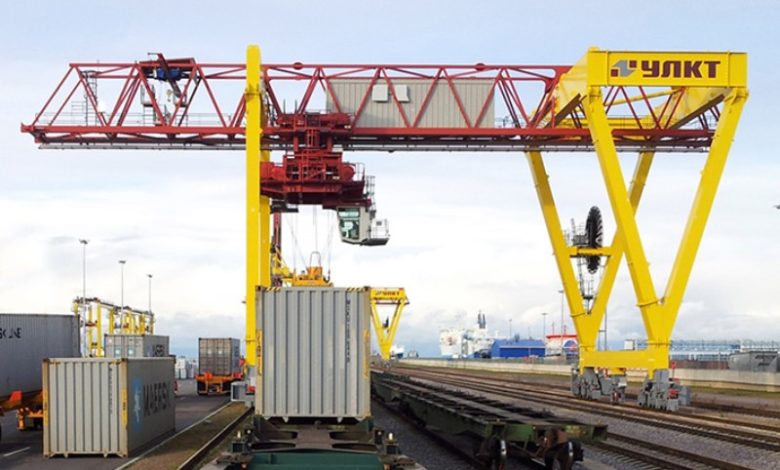Why Gantry Cranes are Essential for Large-Scale Construction and Manufacturing Projects

In large-scale construction and manufacturing projects, the efficient handling and movement of heavy materials is crucial to maintaining project timelines, reducing costs, and ensuring worker safety. One of the most reliable and versatile pieces of equipment used in these industries for material handling is the gantry crane. These cranes, which are equipped with a movable bridge supported by legs or wheels, Why Gantry Cranes are Essential for Large-Scale Construction have revolutionized how large loads are lifted, transported, and placed in a variety of construction and manufacturing settings.
In this blog, we will explore why gantry cranes are essential for large-scale construction and manufacturing projects, highlighting their role in improving efficiency, ensuring safety, and enhancing productivity.
What Is a Gantry Crane?
A gantry crane is a type of overhead crane that is supported by two or more legs, which move along a fixed track or set of wheels. The crane’s bridge, which houses the hoist mechanism, spans across the workspace, allowing the hoist to lift and lower heavy loads. These cranes are unique in that they are not mounted to the ceiling or a fixed structure, as traditional overhead cranes are. Instead, they sit on tracks or wheels, making them mobile and flexible for use in different locations.
There are several types of gantry cranes, including:
-
Single Girder Gantry Cranes – These cranes have a single beam and are suitable for lighter loads.
-
Double Girder Gantry Cranes – These cranes feature two parallel beams and are typically used for heavy-duty lifting tasks.
-
Full Gantry Cranes – These large cranes span across the width of a site and are used for large construction or manufacturing projects.
-
Portable gantry crane – Smaller, mobile cranes that are ideal for smaller-scale applications or confined spaces.
Gantry cranes are used in a wide range of industries, but their versatility and robustness make them especially well-suited for large-scale construction and manufacturing projects.
The Role of Gantry Cranes in Construction Projects
In large-scale construction projects, gantry cranes are often used to handle and move heavy materials, such as steel beams, concrete slabs, prefabricated walls, and construction machinery. The ability to lift and move these materials efficiently and safely can be the difference between a project meeting its deadlines or experiencing costly delays.
1. Efficient Lifting and Movement of Heavy Materials
Construction projects typically require the movement of large and heavy materials, and gantry cranes are capable of handling these tasks with ease. For example, lifting steel beams or large concrete panels into place can be a dangerous and time-consuming process if not done with the right equipment. Gantry cranes provide a reliable solution by offering high lifting capacity, precision, and control over heavy loads.
The crane’s bridge and hoisting mechanism can be customized to lift various materials of different shapes and sizes, making it a versatile tool on construction sites. With a gantry crane in place, workers can quickly move materials to the appropriate location, reducing the time spent manually handling or repositioning materials.
2. Maximizing Space and Accessibility on Construction Sites
Construction sites are often large and cluttered, with limited space for storing and moving equipment. Gantry cranes help maximize space and improve the flow of materials by providing a lifting solution that can move across a wide area. Many gantry cranes are mounted on rails or wheels, which allows them to be positioned anywhere within the construction zone. This mobility ensures that materials can be moved from one part of the site to another, without needing additional stationary cranes or equipment.
The ability to move along a fixed path also reduces the potential for congestion or obstacles on the site, as the crane can avoid high-traffic areas and narrow paths. Whether lifting heavy equipment or simply transporting building materials, gantry cranes help optimize space utilization, ensuring that construction crews have more room to maneuver.
3. Safety and Precision in Heavy Lifting
Lifting heavy materials or equipment poses significant safety risks, particularly on busy construction sites. Improper handling of these materials can result in accidents, injuries, or even fatalities. Gantry cranes, when used correctly, can significantly improve safety by reducing the need for manual lifting or the use of less reliable lifting equipment.
The precision and control provided by gantry cranes make them ideal for delicate operations, such as installing heavy components in tight spaces or lifting large sections of prefabricated buildings. The cranes’ hoisting systems allow for accurate positioning, ensuring that materials are safely and efficiently placed in their desired locations.
Additionally, gantry cranes are typically equipped with safety features such as load limiters, emergency stop buttons, and anti-collision devices, which further reduce the risk of accidents.
4. Cost Savings and Time Efficiency
Time is money in construction, and any delays in material handling can lead to cost overruns. Gantry cranes are designed to improve productivity and reduce downtime, ensuring that construction projects stay on track and within budget. By moving heavy materials quickly and safely, gantry cranes help prevent costly delays associated with manual labor or inefficient equipment.
In addition to improving speed, gantry cranes help minimize labor costs. With the crane doing the heavy lifting, fewer workers are needed for manual tasks, allowing them to focus on other aspects of the project. Furthermore, gantry cranes reduce the wear and tear on other construction equipment, potentially lowering maintenance costs over time.
The Role of Gantry Cranes in Manufacturing Projects
Manufacturing facilities that produce large products or components often rely on gantry cranes to transport raw materials, parts, and finished goods. Whether in automotive manufacturing, steel production, or the fabrication of heavy machinery, gantry cranes are essential in moving large, bulky items across production lines, assembly areas, and storage spaces.
1. Streamlined Production and Assembly
In manufacturing, efficiency is key. Gantry cranes play a pivotal role in streamlining production and assembly processes by facilitating the movement of materials between workstations. In automotive manufacturing, for example, gantry cranes are used to move car parts from one station to another as the vehicle is assembled. Similarly, in steel plants, gantry cranes lift and transport heavy steel coils, beams, and sheets to different processing stations.
By automating the material handling process, gantry cranes reduce the time it takes to complete each production stage, ultimately speeding up the entire manufacturing cycle. The ability to quickly move materials and components between production areas ensures that manufacturers can meet demand and maintain production schedules.
2. Precision in Handling Delicate Components
Manufacturing operations often involve the handling of delicate or expensive components that require precise lifting and placement. Gantry cranes excel in this area, as they offer fine control over the lifting and lowering process. For example, in the aerospace industry, gantry cranes are used to move delicate airplane parts, ensuring they are not damaged during handling. Similarly, in electronics manufacturing, gantry cranes are used to lift sensitive parts like circuit boards or large screens, where precision is critical.
The precision provided by gantry cranes allows manufacturers to safely handle delicate components while maintaining the integrity of the product.
3. Adaptability to Different Manufacturing Needs
Gantry cranes are highly adaptable and can be customized to meet the specific needs of different manufacturing processes. For instance, cranes can be fitted with different types of hoisting equipment, such as electric winches, chain hoists, or hydraulic systems, depending on the weight and nature of the load. The crane’s lifting capacity, height, and span can also be adjusted to accommodate various production requirements.
In addition, some gantry cranes are portable, making them ideal for smaller-scale manufacturing operations or facilities that need to move production equipment to different areas. Portable gantry cranes can be easily relocated within the factory to support different production lines, offering a flexible solution for material handling in dynamic environments.
Conclusion: Gantry Cranes—A Key Asset for Large-Scale Projects
Whether in large-scale construction or manufacturing, gantry cranes are essential tools that significantly improve material handling efficiency, enhance safety, and drive productivity. Their ability to move heavy loads across vast areas, coupled with their flexibility and precision, makes them indispensable in industries that rely on the quick and safe transport of materials.
From lifting steel beams on a construction site to transporting large components in a manufacturing plant, gantry cranes are the backbone of large-scale projects, ensuring that tasks are completed on time, within budget, and with the utmost safety. By improving efficiency, reducing downtime, and minimizing labor costs, gantry cranes contribute to the overall success of construction and manufacturing operations, making them a key asset for any large-scale project.



